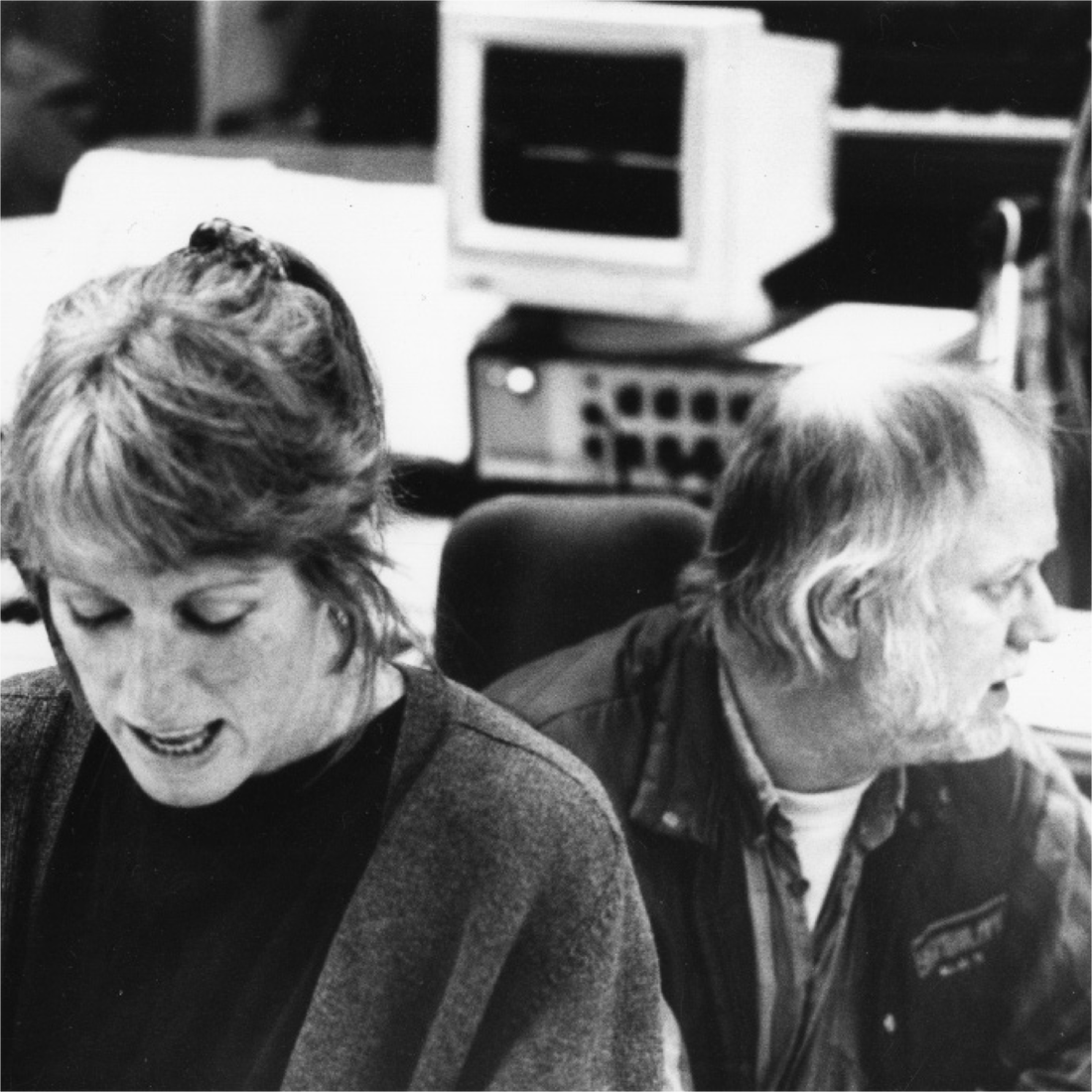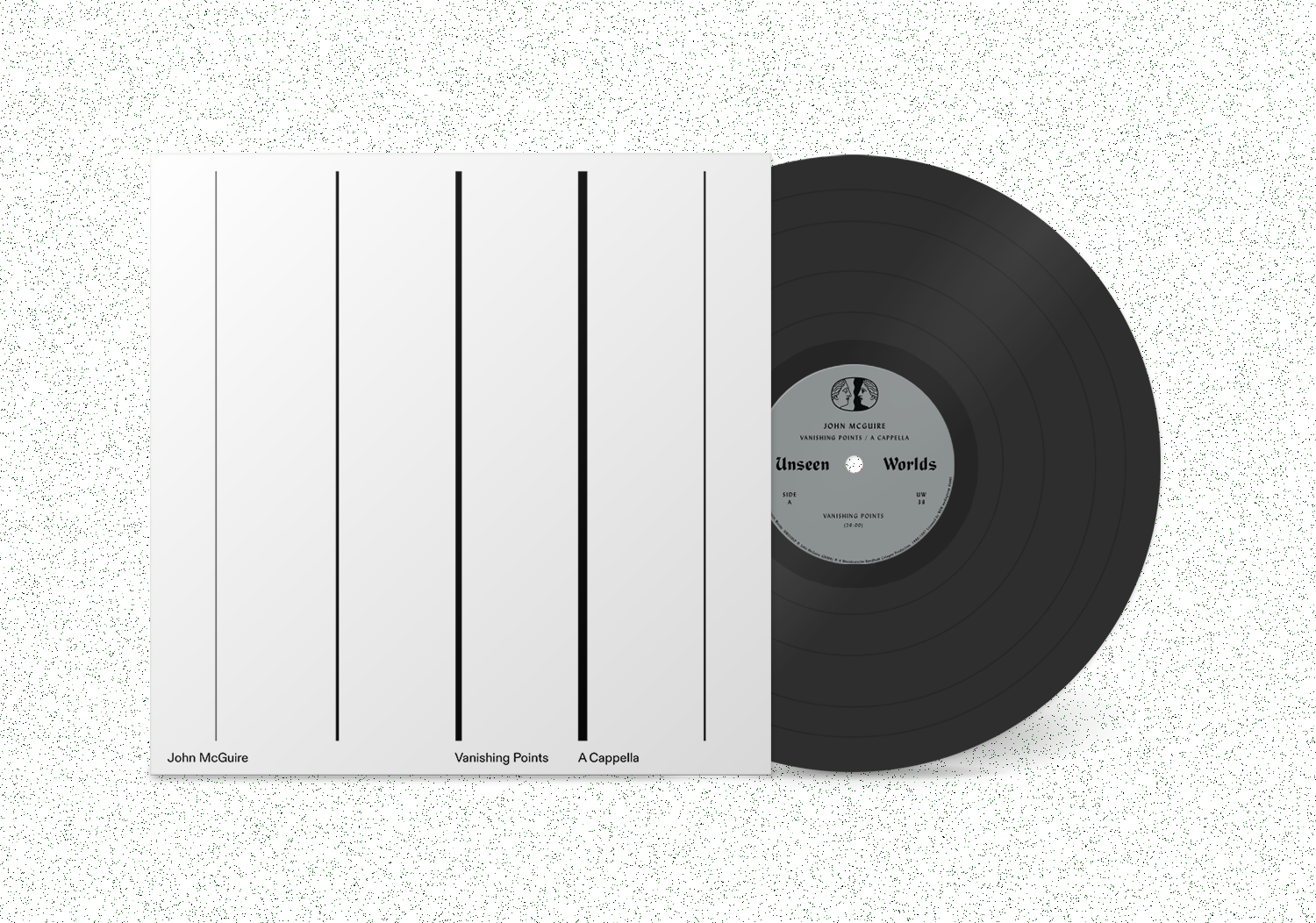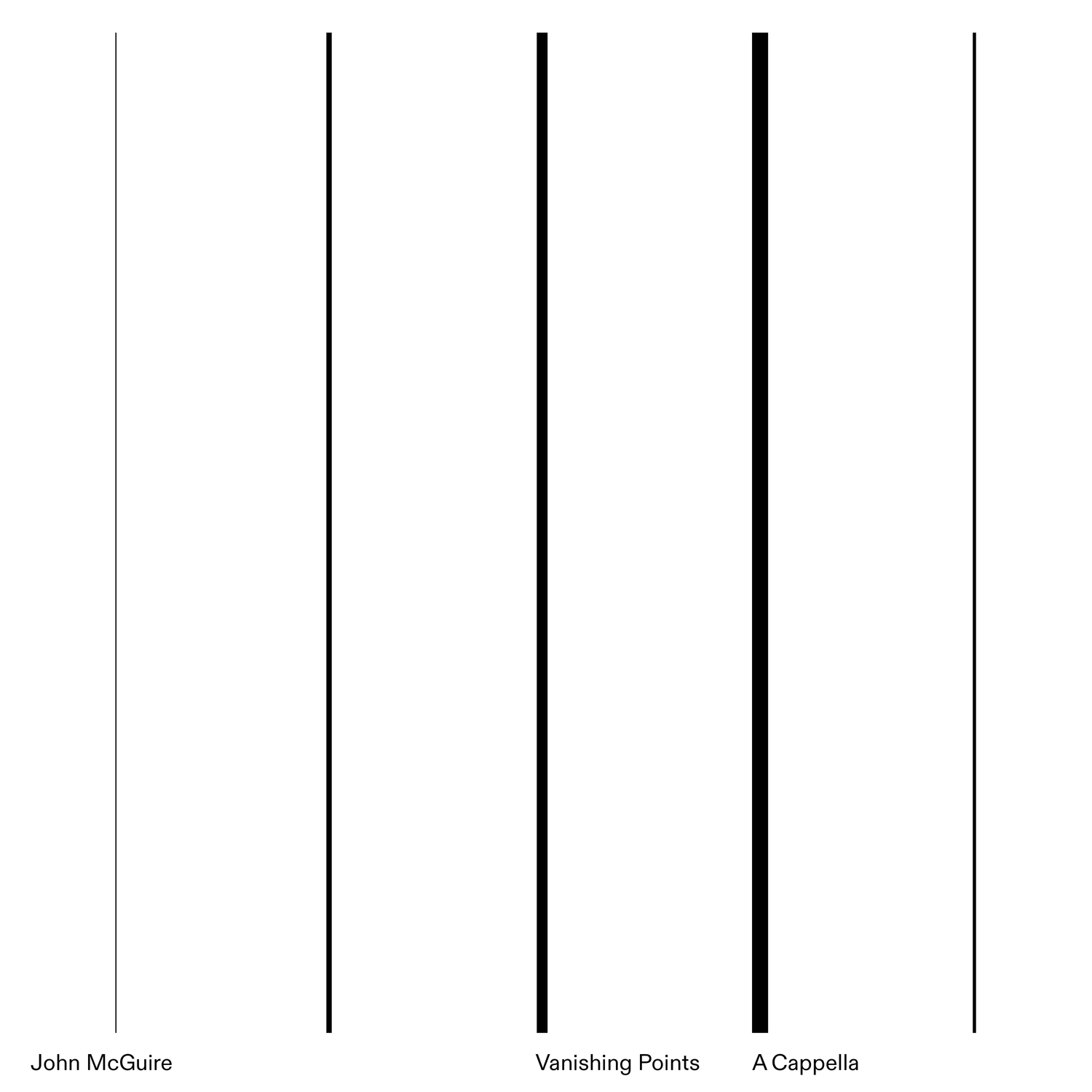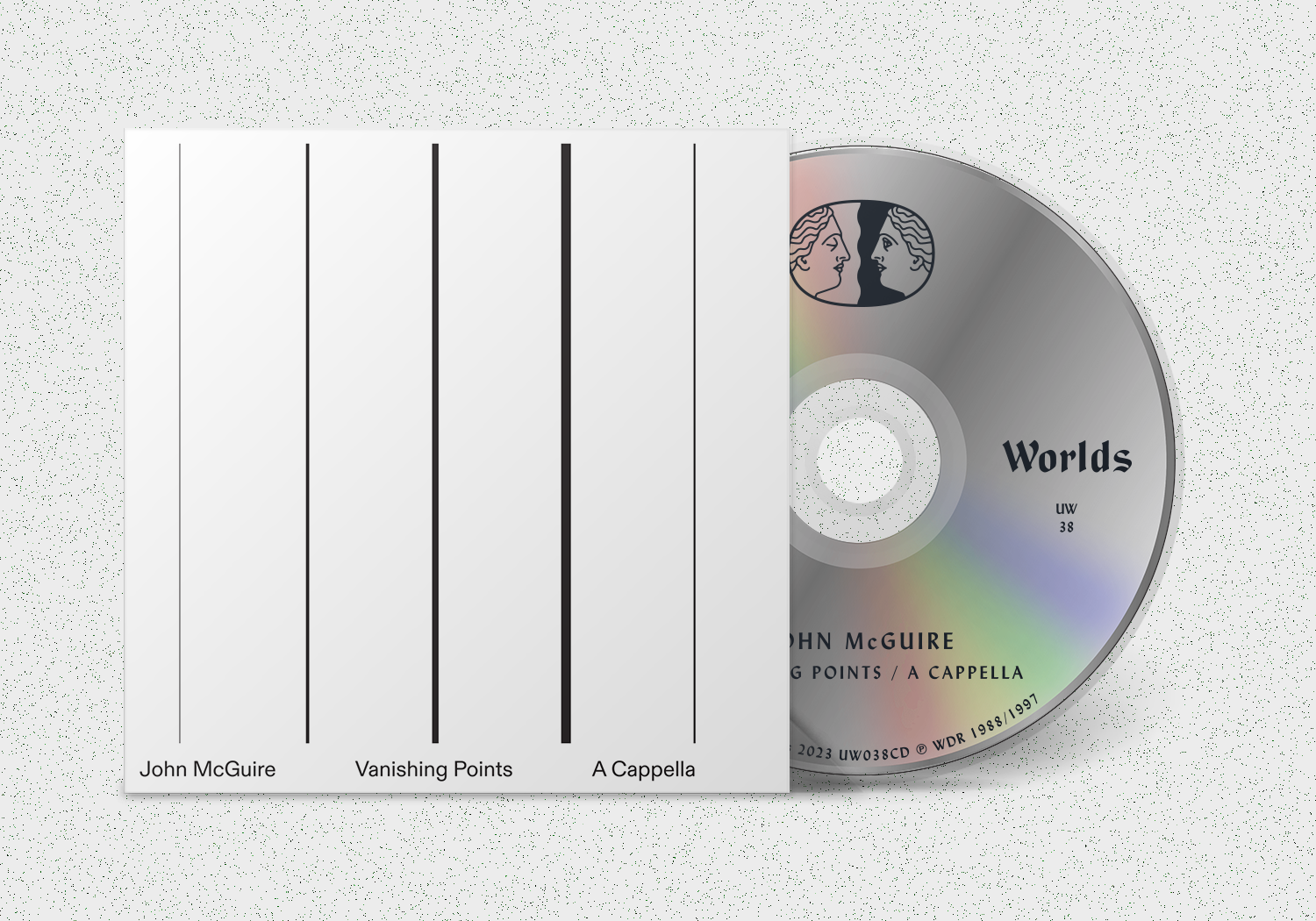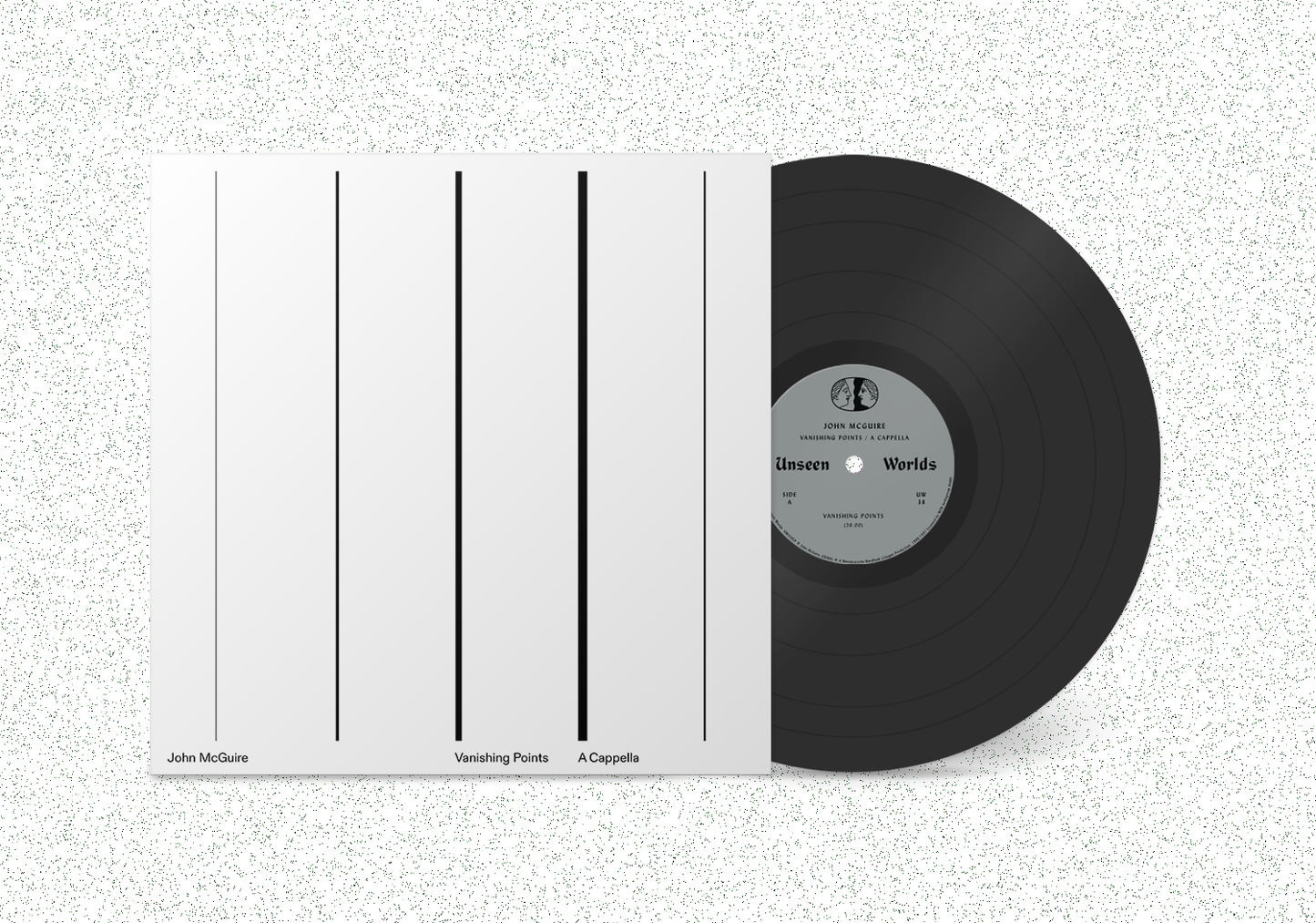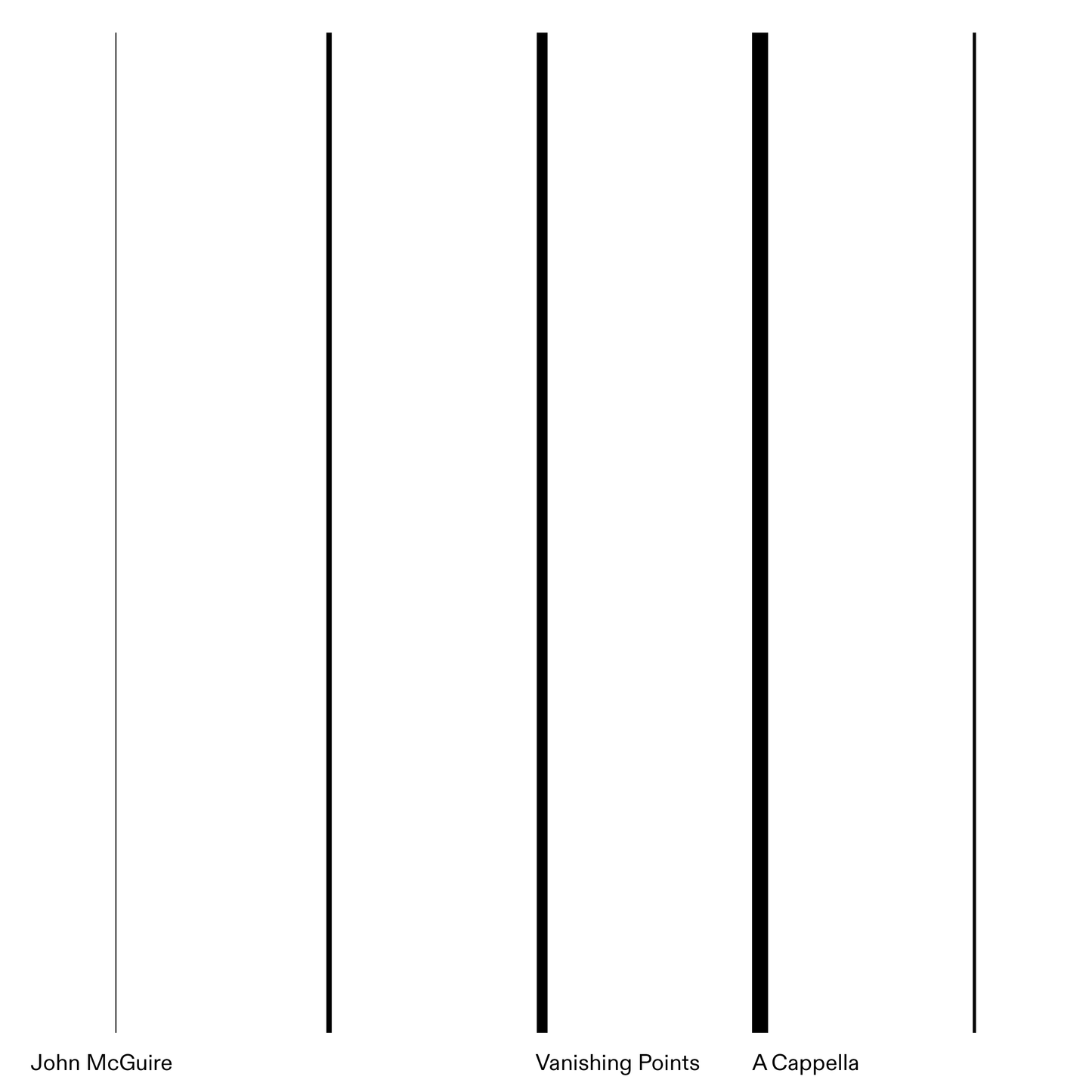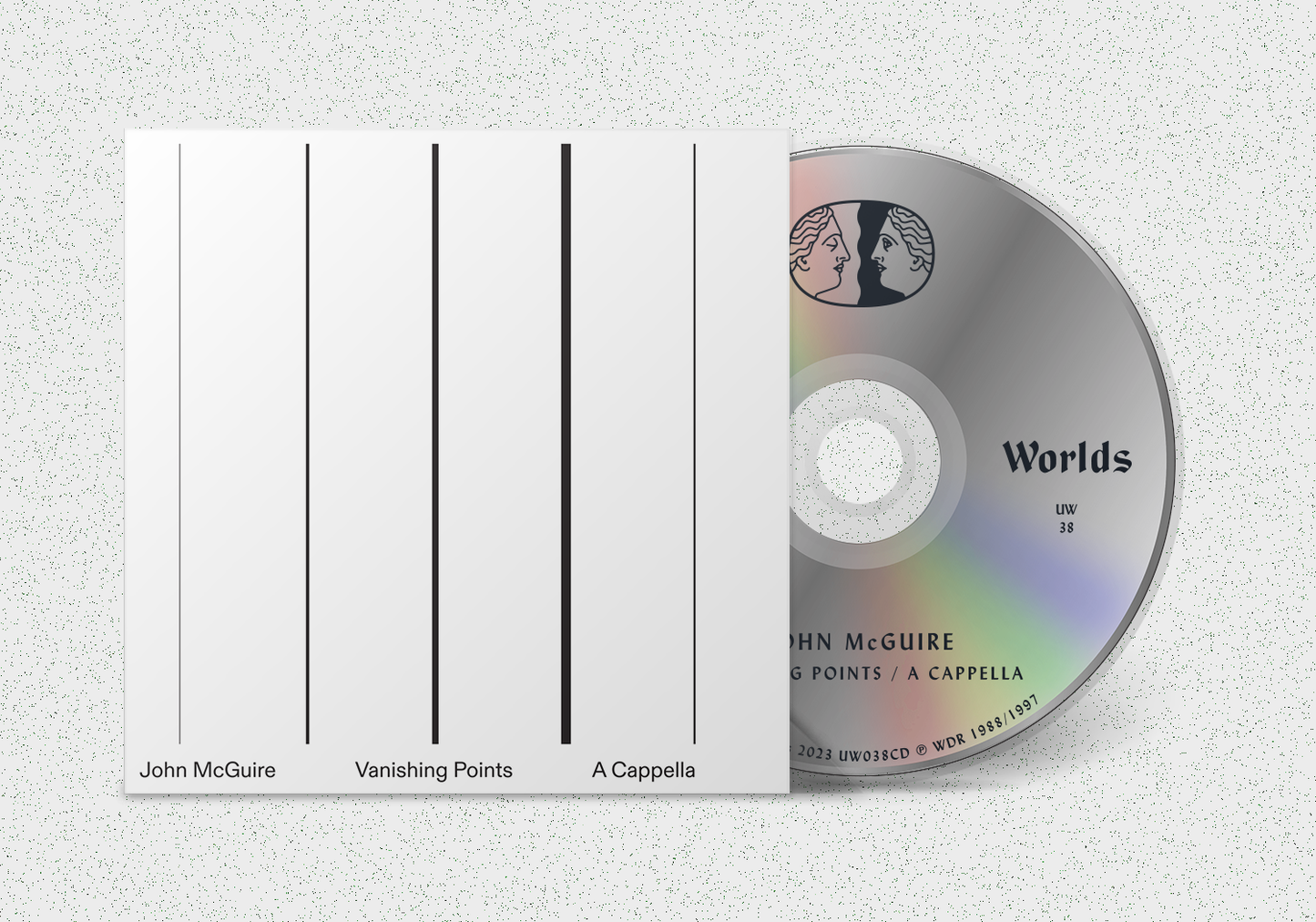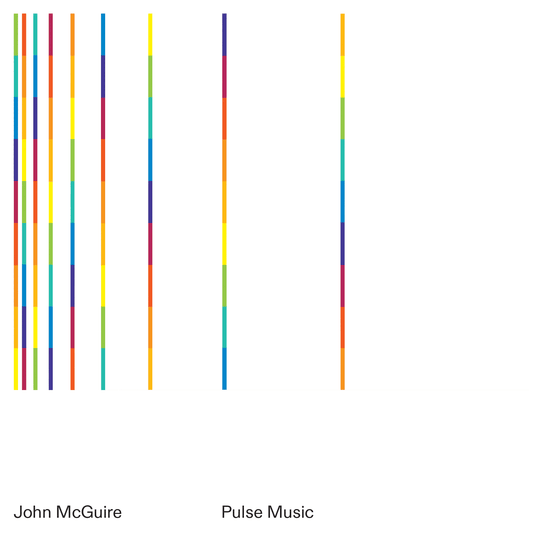Beth Griffith and John McGuire duringthe recording of A Cappella. Photography by Johanna Gunkel.
In his “Pulse Music” compositions of the mid-1970s—108 Pulses, Pulse Music I, and Pulse Music III for tape, and Pulse Music II for orchestra—the Californian composer John McGuire forged a unique interpretation of European serialism. A student of Karlheinz Stockhausen, Krzysztof Penderecki and Gottfried Michael Koenig, McGuire moved to Cologne, Germany in 1970, where he become associated with the world-leading Studio for Electronic Music at Westdeutscher Rundfunk (WDR) in Cologne, the same studios in which Stockhausen had realised his pioneering electronic works Gesang der Jünglinge (1955–6) and Kontakte (1958–60).
Like Stockhausen, McGuire found his musical imagination both constrained and inspired by the technology that was available to him. He had heard performances in San Francisco of Steve Reich’s Violin Phase and Terry Riley’s In C, yet while Reich and Riley were seeking ways to adapt the lessons learned from playing with tape loops at the San Francisco Tape Music Center (often with a psychedelic bent), McGuire’s familiarity with the pulse-generating synthesizers of the Cologne studios led him initially to a cooler, more abstract approach.
For the first Pulse Music pieces, McGuire made use of what he calls a “superdevice,” a combination of synthesizer and multi-track tape player that could trigger synthesizer sounds and record them in perfect synchronicity, which he devised with Marcel Schmidt, audio engineer of the Cologne Hochschule für Musik. The musical and technical implications of this superdevice would occupy McGuire for many years after. Each time he returned to the concept, he was able to adapt it to increasingly sophisticated equipment: Pulse Music III made use of three 8-track Telefunken tape machines connected to the same EMS Synthi 100 on which Stockhausen composed his music theatre work Sirius in 1975–7.
For Vanishing Points (1985–8), McGuire used an entirely digital set-up for the first time: a digital sequencer, eight Yamaha DX-7 synthesizers and a Studer 24-track digital tape recorder. The piece was conceived as a “sequel” to the Pulse Music series, but also a step forward from it. “With this new technology,” McGuire says, “I was able to have a closer look at very high timing resolutions for the construction of what I called ‘acceleration spectra’.” Whereas the Pulse Music pieces had employed steady streams of pulses, with Vanishing Points McGuire employed pulse layers that accelerate or decelerate against one another, vastly increasing the resulting rhythmic complexity.
Inspiration came from a dinner conversation with the sculptor Hans Karl Burgeff (professor of sculpture and bronze at the Cologne Academy of Fine and Applied Arts, 1968–88). At one point, Burgeff—“as he occasionally did,” according to McGuire—launched into a brilliant monologue about how, by preparing people’s minds for thinking and seeing beyond the horizon and into limitless space, the discovery of visual perspective in fourteenth-century Italian painting had been an essential step towards the great European voyages of discovery (and colonisation) of the fifteenth and sixteenth centuries.
For Pulse Music I, McGuire had to work to a sequencer capability of just 12 pulses per second. With his DX-7-based superdevice a decade later, that figure had increased to a reliable 1,792 pulses per second. This high velocity stream constituted the timing resolution of a 10-level spectrum, of which McGuire called the highest (10th) level his “horizon”: the target of the accelerations. By dividing his music into 1.4-second “bars” of 2,520 pulses, McGuire could then allocate between one and ten evenly spaced attacks per bar (2,520 being the lowest common multiple of numbers 1 to 10). Together, these relationships make up a spectrum of related pulse speeds (McGuire calls them “partials,” making an analogy between timbre and tempo that Stockhausen also used in the composition of his Gruppen). By plotting a progressive series of ratios across this spectrum (1:2, 2:3, 3:4 … 9:10), McGuire was able to notate and then realise curves of accelerating and decelerating pulses. Multiplying or dividing his original bar length creates shallower or steeper curves, and by drawing several curves at once, experimenting with their positions and angles (he jokes that photocopies of his basic spectrum of ten partials became his manuscript paper), he could create elaborate fan-like designs.
Already complex on two-dimensional paper, once translated into criss-crossing streams of pulses, these designs generate a multi-dimensional topography of multiple horizons, multiple simultaneous lines of perspective. The steady-state environments of the Pulse Music pieces are transformed into maps, with landmarks, contours, horizons and perspectives. By giving shape to his pulse streams, McGuire gave them a narrative dimension: they form into cadence-like groups of sound, with beginnings and ends.
That impulse-decay dynamic is furthered in McGuire’s first work involving voice, A Cappella (1990–97), written for his wife, the soprano Beth Griffith. Griffith is one of the most acclaimed contemporary music singers of the twentieth century, known particularly for her multitracked, solo recording of Morton Feldman’s Three Voices made in 1983. In A Cappella, she plays a different call-and-response game with a chorus of sampled copies of herself.
McGuire began by making samples of Griffith singing the vowels e, ah and u at different pitches across her complete range. Grouping these according to the two parameters of register and tempo, he was able to create a four-voice choir of voice samples: higher/faster, higher/slower, lower/faster and lower/slower. Using first Cubase (and a total of fifty floppy disks!) and a Fairlight sampler, these were arranged into a monophonic sequence of interacting parts—a hocketing groove of two- and three-beat rhythms, inspired by Bartók’s Six Dances in Bulgarian Rhythm; long pitches that hang languorously over the texture like the climax of a Baroque aria; and falling chime patterns that indicate changes in harmony or beat pattern, like the unison signals between musical sections in Ghanaian drumming or Reich’s Music for 18 Musicians. Griffiths’ voice would initiate a musical phrase, usually as a more sustained phrase, and her electronic chorus would respond in an overlapping chain of live and electronic voices. Several years later, and now with access to the digital audio workstation Pro Tools, McGuire was able to apply dynamics and spatialisation to the sequenced samples to create the finished work.
Working with vocal samples rather than synthesized pitches presented McGuire with challenges he hadn’t faced before: he notes especially the fact that the human voice, given a specific pitch to sing, spends around a tenth of a second searching for that note before settling on it, while a synthesizer finds it instantaneously. If that voice is then sequenced into a fast-moving stream of samples, this can cause devastating problems of intonation (even for a singer of Griffith’s precision). One reason the piece took so long to make was the laborious process of editing out all the “search processes” from the vocal samples. Composition, McGuire says, is always “a matter of negotiation between the ‘material’ and an ‘original conception’. In other words, adapt the material to match the original conception, but also adapt the original conception to match the material.” This sort of negotiation applies as much to the composition of a single piece as it does to the work of two decades.
- Tim Rutherford-Johnson, 2022
Notes by John McGuire
Vanishing Points and A Cappella were produced in the Studio for Electronic Music, West German Radio, Cologne. They were commissioned by the radio as part of its electronic music commissioning program at the behest of Wolfgang Becker-Carsten, head of the Department of New Music at the WDR.
Vanishing Points was written in the years 1985–1989 and produced in the studio during 7 months’ production time in 1989–1990. The premiere took place in Cologne, 1990, as part of the annual International Computer Music Conference.
A Cappella was written in1990-1997 and produced in the studio during 10 months’ production time in 1996 and 1997. The premiere took place as part of the Cologne Triennial 1997. In the composition of both pieces time structure and its notation was the first emphasis.
Vanishing Points
In the case of Vanishing Points I wanted to suggest a temporal analogy to perspective drawing, in which case a “horizon”, or more precisely, “target frequency” could be approached (accelerando) and departed from (decelerando) at many different angles in a manner suggestive of perspective drawing, but in time rather than space.
In the case of a temporal version of perspective drawing this would require a web of intersecting waves of speed. Acceleration – movement toward the target frequency, and deceleration – movement away from the target frequency, form the foreground events.
So the question was: how to coordinate the various components of such an image? After an extended search I arrived at a single spectrum in the temporal domain (the domain in which we can hear individual pulses rather than continuous streams) which could be interpreted in multiple ways depending on the number of partials in the spectrum, the number of spectra that had been strung together and on the angles of the accelerating and decelerating motions; the spectra functioned as nexuses for all of the intersecting curves.
First I made a “manuscript paper” picturing spectra with 10 partials and therefore a timing resolution (Lowest Common Denominator) of 2520 pulses.

The value 2520 became the basis for all calculations of speed and duration. The sequencer with which I was working was capable of 1792 pulses per second, which became the maximum possible speed for the project time structure.

Using my new “manuscript paper” I could plot changes of speed, or intersecting waves of speed, at will, eventually developing the fan-like structures which I felt embodied a kind of perspective drawing in time. Variants of these structures became the basis of a each of the twelve sections of the piece.

Time structure schematic, Vanishing Points. The three most important levels of the time structure are the highest levels which comprise the control frequencies (from 428 to 1792 Hz) by which the digital sequencer was triggered from the 24-track digital tape recorder. This entire sequence of 13 speeds was recorded on one of the 24 tracks in preparation for use of the digital sequencer. The sequencer, in turn, released sounds from a TX816 – a rack of 8 DX7s – in quadraphonic circles of varying length and speed, including sections with up to 15 simultaneous quadraphonic circles (60 tracks). As can be seen in the example, the entire time structure encompasses about 12 octaves.

Connections between adjacent sections are made by shared frequencies as shown in the example: 2:5, 4:5, 8:5. Resultants of these proportions determine the rhythms of peaks in each section.

MIDI diagrams for quadraphonic rotation. The numbers I, II, III and IV designate the four channels; the numbers following these are MIDI values 42 (barely audible) to 127 (maximum), indicating the two volumes on each channel for each pulse, and therefore the position of each pulse in quadraphonic space.


Spatial positions of peaks (quadraphonic). 2, 4, and 8 (upper diagram) against 5 (lower diagram). All 12 sections have, at their peaks, rhythms resulting from the superimposition of 2:5, 4:5 and 8:5.

Protocol for recording. The completed picture required 90 tracks of recordings. The digital tape recorder had 24 tracks, which meant that mixdowns had to be plotted before recording, using a kind of “score”. With a digital tape recorder many mixdowns could be made with no loss of signal.

Shows one of two pages of the recording score – with numbers and placement of the recordings of 5:2 curve relations. There were three kinds of recorded pulses: SP = Small Pulses, MP = Medium Pulses, LP = Large Pulses, according to placement in space and function (marking of peaks, etc).

Diagram of the setup, built by Volker Müller, by which I was able to call up all the sounds necessary to relaize quadraphonic pulse sequences as well as entire sections of the piece.
A Cappella



 Photography by Johanna Gunkel. All of the photos of John McGuire, Beth Griffith and Volker Müller during production of A Cappella.
Photography by Johanna Gunkel. All of the photos of John McGuire, Beth Griffith and Volker Müller during production of A Cappella.
In the fall of 1990 I wrote to Wolfgang Becker-Cartsten at the WDR to propose a project for soprano and electronics to be realized in the Studio for Electronic Music. The plan was to collaborate with my wife, soprano Beth Griffith, on the project. I wanted to attempt a musical portrait of Beth, two of whose vocal qualities were especially interesting for the project I had in mind: her variety of color and her rhythmic precision.
After many collaborative experiments one idea seemed to capture both of these qualities: a rhythmic automat whose proportions and durations could expand and contract along several different paths which might be differentiated by vocal colors.
The basis for a structure like this had to be something very simple at its core, but ambiguous enough to imply or suggest a world of variants.
I began by playing various mixtures of 2 eighths and and 3 eighths on my piano as I had first encountered in the music of Bartok many years previously.
“2” and “3” are of course components of the Fibonacci series (1, 1, 2, 3, 5, 8, 13 etc.) and I soon noticed that certain sequences of 2+3 add up to higher Fibonacci numbers such that rhythm generates duration, and vice-versa. Below are examples of four possible sequences, all of them adding up to Fibonacci values. This latter information was useful in the development of larger scale structures:
|
Pulses Units of 3 and 2 |
Sequences |
|
13 5 |
33232 |
|
21 8 |
33233232 |
|
34 13 |
3323323233232 |
|
55 21 |
332332323323323233232 |
|
etc. |
The sequence of units in any of the 13 sections of the piece is determined by the inclusion of enlarged or reduced versions of the starting level (3+2):
332332323323323233232
35 35 5 35 35 5 35 5
8 8 5 8 8 5 8 5
8 13 8 13 13
21 21 13
21 34
55
I then reversed the order of each progression to generate pairs of criss-crossing progressions (“A” and “B” in the diagram below). Each of the 13 sections of the piece consists of a criss-cross process of this kind, alternating processes of contraction (A) and expansion (B).
| A | B |
| 55 | 13 |
| 332332323323323233232 | 23233 |
| A | B |
| 34 | 21 |
| 3323323233232 | 23233233 |
| A | B |
| 21 | 34 |
| 33233232 | 2323323233233 |
| A | B |
| 13 | 55 |
| 33232 | 232332323323323233233 |
This criss-cross structure suggested a chain of transitions, each of whose sections would recollect the previous section and predict the following section, connecting adjacent sections to one another via common structures (B = A):
Section: I II III IV V VI etc.
A|B = A|B = A|B = A|B = A|B = A|B
The large numbers (left = A, right = B) have been broken down into smaller unit components (e.g. 21 = 33233232). Each half A and B consists of a four-stage progression of durations:
| A (3+2) | B (2+3) |
| 89 | 55 |
| 55 | 89 |
| 34 | 144 |
| 21 | 233 |
The notation used in this example, by separating A (3+2) from its reverse B (2+3) made possible a greatly accelerated programming of the Cubase sequencer. Use of this notation meant that the time needed to program a section of the piece was reduced from two weeks to two hours.



 Design for the motion in space of the recorded voices, realized over Pro Tools.
Design for the motion in space of the recorded voices, realized over Pro Tools.

 A Cappella recording protocols for vowels (a, h, e, u) (German i, a, u).
A Cappella recording protocols for vowels (a, h, e, u) (German i, a, u).
